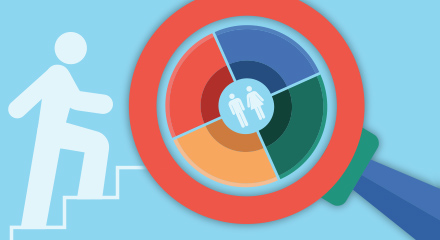NINE STEPS TO ACE YOUR SKYPE INTERVIEW
Posted 3/21/2020In the early and mid 1990s, there was much talk about video interviewing and video conferencing replacing the phone meeting—and possibly some in-person meetings—but it never happened. Even as the technology improved over the years, the costs were often prohibitive and the video conference was often difficult to set up (i.e., finding locations that had video conferencing equipment for both parties).
Today, video conferencing is making a comeback in the form of Skype. For those not familiar with Skype, it is a software for making Internet phone and/or video calls. It is offered in two basic versions. One is free and allows you to talk with people by phone through your computer/over the Internet (if you have a video cam or video camera software as well as a microphone and the other party does also, you can actually sit at your computer and “speak” using audio and video). The other version of Skype requires a credit card to “buy” time. You can then make phone calls to literally anyone over the Internet using your computer, even if they don’t have Skype, by dialing their phone number. There are other video software programs such as GoToMeeting that also allow for conferencing, but from my experience, Skype is used far more prevalently by interviewers than anything else.
With both Skype versions, you download the software from the Internet, create a name/identity (and a small profile for your- self, if you wish) and you are in business.
Though the technology is still evolving (we’ve had more than one Skype interview that had to be scuttled and changed to an old-school phone interview due to technical difficulties), its use will only continue to grow. So here are some tips to help make your Skype video experience a positive one.
- Chill, Jill. Don’t be nervous. Admittedly, it’s not a natural setting to be talking to a person over a computer, but try to relax and just be yourself.
- The eyes have it. When people sit in front of a camera on a video call, they almost always either look right at the monitor or around the room while talking—much like people do when they’re talking on the phone. The problem is you then lose eye contact with the interviewer. In a face-to-face inter- view, you will most likely be looking straight at the person, but people don’t usually do that in a video interview, so the key is to make sure you’re looking right in the camera lens. Some people say it doesn’t feel natural at first to look at a little dot on your computer, but the results are powerful on the other end—you’re now looking the person on the other end of your video call right in the eye.In addition, try not to take too many notes during a Skype interview because you lose that important visual connection with the person on the other side of the screen. Also, while it’s not unusual during a phone interview for a candidate to Google something on the computer to reference a topic being discussed, avoid this during a Skype interview. It can look strange to your interviewer if your eyes dart around from the screen to the keyboard (and not the lens), and very distracting, as well. Think of a newscaster: the most engaging and effective ones usually look straight at you (into the camera), not down at their notes.
- Smile when you say that, pardner. Simple one—when saying hello to your Skype partner, smile. I’m still amazed how a smile eliminates much of the clinical, stilted, awkward feel from a video interview and lets you connect with your interviewer more effectively. At the end of the call when closing and thanking the person for their time, don’t forget to flash those pearly whites again.
- We’re talking about practice? To quote Allen Iverson, yes, we are. Get dressed in your interview outfit and set up a mock Skype video phone call to see how you appear on video. Your practicing video partner might find that you’re too far away or too close and that they are seeing just a close up of your face (not flattering for most of us, since it often gives a mall photo-booth or driver’s license photo look). Generally, the camera should capture your head, shoulders and at lowest halfway to your waist. If you plan to take any notes at all, simulate that during your test. During one candidate’s Skype run-through, his note-taking on a shaky desk/table caused the camera to shake, and from our end it looked like there was an earthquake in progress.
- Lights, camera … Use the best possible lighting. If you have an overhead light as well as other lamps in the room, experiment during your practice section to get the best light for your close-up.
- Clean up your act. Take a look behind where you’re sitting. What will your inter- viewer see in the background? During one Skype test interview with a candidate, I stepped into the room where the call was taking place to take a look and saw a very well-dressed lighting professional. When he asked how he looked, I told him, “You look great–my only concern is that the pat- tern of your tie doesn’t match the one on your ironing board cover.” The candidate jerked his heard around realizing in horror that his folded-up ironing board was in view of his video cam. This is not atypical since many people’s computers are in a home office. In the same vein, clutter and piles of paper can also be distracting, not to mention a concern to a potential employer, so as part of your Skype test make sure you have cleaned up your act.
- It’s all in the name. Most candidates interviewing via Skype for the first time had never used Skype at all in the past (a good percentage had never even heard of it). Many tweens and teenagers do have video cameras in their computer, but they often have Skype names that you might not want to give to a potential employer for your interview. “IluvJustin” or “KatyP4ever” might be fine for your daughter or son, but creating your own Skype identity with your first and last name (or something very close) is most appropriate for an interview.
- Repeat: This is not a phone interview. People on Skype interviews, even though they know it’s a two-way video conference, can forget the other person can see them as well. We’ve heard stories about a candidate clearly exhaling or even rolling their eyes upon hearing a question from the interviewer. It goes without saying that this is not a good play.
- Dress accordingly. Your attire should definitely be business professional, not business casual. The one exception could be for a position with a lighting design firm, where business casual attire may possibly be appropriate in certain cases. We recently had a Skype video interview where the candidate was a well-respected, up-and coming lighting designer in Florida. Florida often has more casual business attire due to the weather, and, in this case, we found out later that she wore a halter top to the interview. You also want to avoid any clothing pattern that is too busy, as that can sometimes play havoc with the video image. For almost all positions in the light- ing, LED, electrical and energy arena, get rid of all facial piercings, as well.
Another thing to get rid of for the guys out there: facial hair. Be sure to shave before your Skype interview. We had one New York candidate interviewing with a high- end architectural lighting fixture manufacturer. He came from a lighting design firm and sported the trendy one-day stubble beard (previously known as the Miami Vice look). While it may play in certain circles, it doesn’t go over as well in most other parts of our industry. More importantly, on a Skype computer video screen, it just didn’t look good. We suggested he shave it all off, which he did, and he got the job. Remember, hair grows back—great opportunities don’t always do the same.
If you’re planning on interviewing in the future and think you might not ever have a video interview, think again. Following the simple guidelines above will make sure that when the opportunity arises for your video interview, you’ll be ready for your close-up.
Nine Steps to Ace Your Skype Interview(464 KB)
Reproduced with the permission of LD+A



